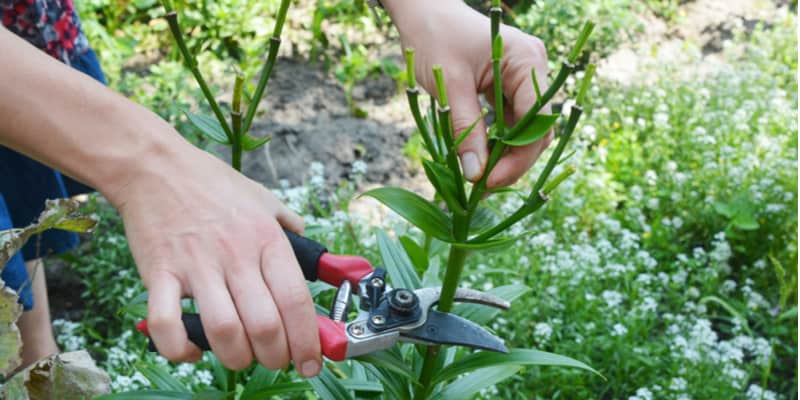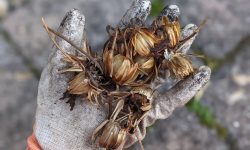After your lilies bloom, you may be wondering what to do with the rest of the plant. Here are a few suggestions on what to do after lilies bloom: First, cut off the spent flowers. This will help the plant to focus its energy on producing new growth.
Next, fertilize your lily plants. This will give them the nutrients they need to produce more blooms next season. Finally, water your lilies regularly.
This will keep them healthy and hydrated so they can continue to thrive in your garden.
After your lilies bloom, it’s important to deadhead them. This means cutting off the spent flowers so that the plant can focus its energy on producing new ones. You can either cut the stem all the way back to the ground or just below where there are new buds forming.
If you want to keep your lilies looking neat and tidy, you can also remove any yellowing leaves.
How to deadhead your lilies
What to Do With Indoor Lily Plant After Flowering
After your indoor lily plant flowers, you may be wondering what to do with it. Here are a few options for you:
1. Cut the stem back to about 6 inches (15 cm) above the soil line.
This will encourage new growth and another round of blooms.
2. Leave the stem intact and allow the plant to go into dormancy. Once the leaves turn yellow and die back, cut the stem back to about 6 inches (15 cm) above the soil line and then water sparingly until new growth appears in springtime.
3. Dig up the entire plant, including the bulb, and replant it outdoors in a sunny spot. Be sure to dig a hole that is twice as wide as the bulb itself so that it has room to grow. Water regularly until established, then reduce watering frequency as needed.
What to Do With Asiatic Lilies After They Bloom
Asiatic lilies are one of the most popular flowers in the world. They are beautiful, fragrant, and easy to care for. But what do you do with them after they bloom?
The first thing you need to do is cut off the spent blooms. This will encourage the plant to put its energy into producing new buds for next season. After cutting off the blooms, give the plant a good watering and fertilize it according to package directions.
Once the plant has finished blooming, you can either leave it in its pot or transplant it into a larger one. If you live in an area where winters are cold, it’s best to bring your lily indoors before the first frost. Keep it in a cool, dark place until spring when you can move it back outdoors.
With proper care, your asiatic lily will bloom again next year and provide you with many more years of enjoyment!
What to Do With Lilies Over Winter
Lilies are a beautiful flower that add a touch of elegance to any garden. However, if you live in an area with cold winters, you may be wondering what to do with your lilies over winter. Here are a few tips to help you keep your lilies healthy and happy during the colder months:
1. Bring Them Indoors: If you have potted lilies, bring them indoors before the first frost hits. Place them in a sunny spot near a window and water them regularly. You may need to mist them occasionally to prevent the leaves from drying out.
2. Mulch Them: If your lilies are planted in the ground, mulch around the base of the plant before the first frost hits. This will help protect the roots from freezing and will also provide some extra insulation for the plant itself. Be sure not to pile the mulch too high, as this could damage the stem or leaves of your plant.
3. Water Them Well: Before winter sets in, water your lilies deeply so that they have plenty of moisture to get them through those dry, cold months ahead. Once winter has arrived, continue to check on your plants periodically and water them if necessary (if the soil is dry).
4. Fertilize Them: Lilies love fertilizer!
Give them one last feeding before winter sets in (following package directions) to give them an extra boost going into dormancy.
How to Prune Lilies After Blooming
Pruning lilies after blooming is a simple process that helps to ensure the plants remain healthy and vigorous. The main goal of pruning is to remove any dead or diseased leaves, stems, or flowers. This will also help to encourage new growth.
To start, cut away any dead or dying leaves, stems, or flowers. Next, trim back any long or overgrown shoots. Finally, cut away any damaged or diseased tissue.
Be sure to disinfect your pruning tools between each cut to avoid spreading disease.
After you have finished pruning, it is important to fertilize the plants and water them deeply. This will help them recover from the stress of being trimmed and promote new growth.

Credit: www.hydrangeaguide.com
What to Do With Lilies When They Finish Flowering?
When your lilies finish flowering, it’s important to remove the dead flowers and seed pods. This will encourage new growth and prevent the plant from going into dormancy. Cut the stem back to a healthy leaf node, about 2-3 inches above the soil line.
You can also remove any yellowing or brown leaves at this time. Once the plant is trimmed back, water it well and fertilize with a balanced fertilizer.
When Should Lilies Be Cut Back?
Lilies (Lilium spp.) are among the most versatile and beautiful flowering plants. They come in a wide range of colors, shapes and sizes, and can be grown in nearly any type of garden. While lilies are relatively easy to care for, they do require some basic maintenance throughout the growing season.
One of the most important tasks is to properly prune or cut back lilies after they have finished blooming.
Cutting back lilies is important for a number of reasons. First, it helps to keep the plant tidy and prevent it from getting too leggy or untidy-looking.
Additionally, cutting back spent flower stems encourages the plant to produce more flowers the following year. Finally, removing old leaves and stems helps reduce the risk of fungal diseases such as botrytis rot, which can affect both lilies and other nearby plants.
The best time to cut back lilies is after they have finished flowering and before new growth begins in spring.
Cut each stem down to about 6 inches above ground level using sharp shears or pruning snips. If desired, you can also remove any remaining leaves at this time; however, doing so is not strictly necessary. Once all stems have been trimmed, give the plant a light shaping if needed to maintain its desired shape.
How Far down Do I Cut My Lilies?
When it comes to cutting lilies, the general rule of thumb is to cut them down about an inch or two from the ground. However, there are a few things you should keep in mind when doing so. For starters, make sure that you have a sharp knife or shears on hand.
This will help you get a clean cut and prevent any damage to the plant. Secondly, be sure to remove any leaves that are below the cut line as these can rot and cause problems for the plant. Finally, remember that lily bulbs are poisonous, so take care not to cut yourself when handling them!
Do You Cut Lilies down for the Winter?
No, you don’t have to cut lilies down for the winter. They are perfectly capable of surviving the cold weather and will come back to life in the spring.
Conclusion
Once your lilies have bloomed, it is important to take care of the plant so that it can continue to produce flowers for years to come. Here are some tips on what to do after lilies bloom:
1. Cut back the spent flower stems to encourage new growth.
2. Fertilize the plant with a balanced fertilizer and water regularly.
3. Deadhead any brown or yellow leaves as they appear.
4. In late summer, cut back the foliage by half to help the plant prepare for winter dormancy.






